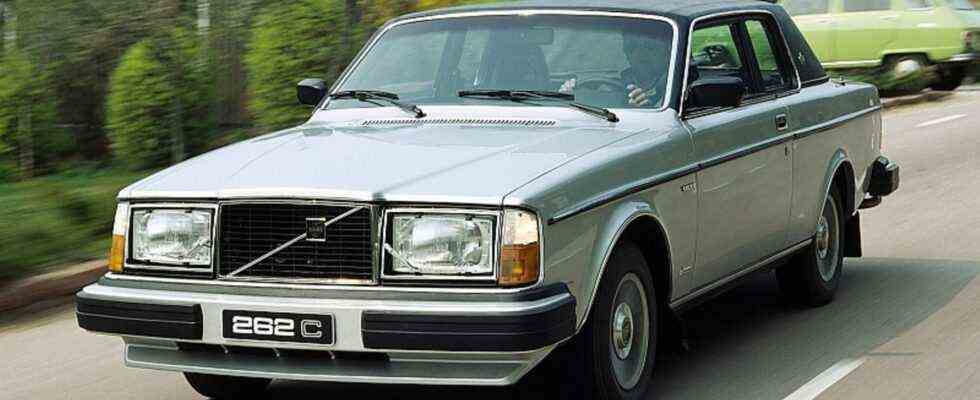Volvo 262 C.
The elegant squared timber
Volvo 262 C.
© press-inform – the press office
Volvo, through its long-time chief designer Jan Wilsgaard, stands for emphatically angular design and practical family sedans. But there is another way. The Volvo 262 C has been an exclusive exotic vehicle on the classic market for years.
So this is what an emotional luxury coupe from Scandinavia looks like. While flowing forms were celebrated in Italy at Ferrari, Maserati or Alfa Romeo, Germany was honored with the Porsche 911, or people were impressed by the Mercedes Coupé and the Americans used their two-door models with sweeping shapes and gigantic engines, things were very different in Sweden the end. Jan Wilsgaard, the Brooklyn-born Swede, left his mark on the car brand for more than three decades. After models like Volvo Philip or the Amazon, there was a design break at Volvo and the following 140 reinvented the Swedish brand. The spacious interior, large windows and clear lines were striking. The angular, chunky series of the upper middle class was a success. The 142, 144 and 145 models were sold more than 1.2 million times. Wilsgaard followed up with the 164. The 164 had arrived in the middle of the high-yielding luxury class and Volvo had a new flagship. The Swedes returned to the luxury class in 1968 with the deliberately luxurious sedan. In addition to comfort equipment and powerful six-cylinder engines, the four-door model offered, among other things, a safety passenger cell with meticulously calculated crumple zones. Chief designer Wilsgaard used the chassis of the Volvo 140 and combined it with the front design of the prototype P358 from the 1950s. The Volvo brand emblem, the Iron Mark, was placed particularly prominently on the radiator grille. It sat on the brand-typical diagonal, just like the very first Volvo from 1927 and the way it is used to this day.
So that the newly developed B30 in-line six-cylinder could fit onto the chassis of the Volvo 140, it was lengthened by ten centimeters from the windshield. The six-cylinder had a displacement of three liters and, thanks to a Zenith-Stromberg double carburetor, developed an output of 107 kW / 145 PS. But for the brand’s 50th birthday it should be something very special. The first prototype of the luxurious Volvo 262 C coupé, built in Italy, was also based on a Volvo 164. Bodybuilder Sergio Coggiola from Turin transformed the sedan into a two-door coupé with a vinyl roof, which largely corresponded to the later production model. An important difference was the front design of the prototype in the style of the Volvo 164.
The Volvo 262 was the rarest variant of the very successful 240/260 series. The model, which was only offered between 1975 and 1981 and in a few markets, was a two-door variant of the six-cylinder Volvo 264 sedan.Like the four-door Volvo 264, the Volvo 262 received all of the design and equipment elements of the Volvo top model – the distinctive ones , large grill and the luxurious interior. The Volvo 262C premiered in 1977 at the Geneva Motor Show. The Italian coachbuilder Bertone developed and built this Volvo Coupé with its unique flat roof structure according to the specifications of the Volvo designer Jan Wilsgaard and designs by Sergio Coggiola. Further design features of the 4.98 meter long Volvo 262C were the steeply rising windshield and the wide C-pillar. In the first years of sales, all Volvo 262 Cs were painted in noble silver metallic, while the roof was covered with black vinyl. The color palette was later expanded to include additional exclusive tones and the coupé was manufactured until 1981. Thanks to the unchanged wheelbase from the Volvo 264, the coupé offered a spacious interior, but in contrast to the sedan it had two individual seats in the rear. Noble materials such as wood and leather convey a particularly luxurious ambience in the Volvo 262C. A show back then: the vinyl roof, although not all models have it.
While just 3,329 vehicles of the four-door Volvo 262 were produced, the two-door coupé variant came in at least twice as many with 6,622 units. The 262 series was available with two 2.7-liter six-cylinders that developed 129 and 155 hp, respectively. The customer had the choice between a four-speed manual transmission and a three-speed automatic transmission. Both engines did not allow sporty ambitions and so the Volvo 262 C was more about the design than ever. The equipment of the Volvo 262 C left little to be desired – electric windows, heated leather seats, air conditioning and the usual Volvo safety equipment. The market for the Volvo 262 C is manageable, but despite its cult character, the prices are manageable. Good copies are available from around 15,000 euros.


